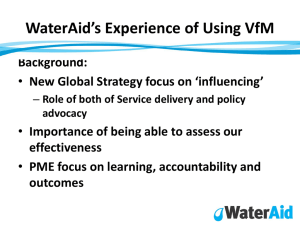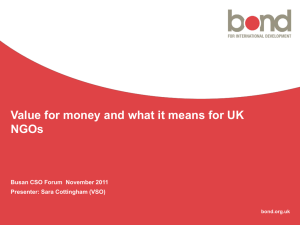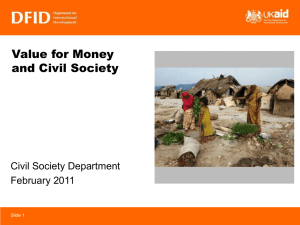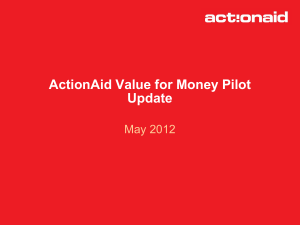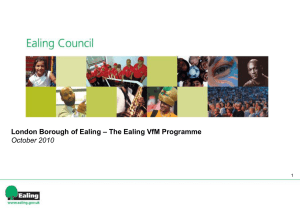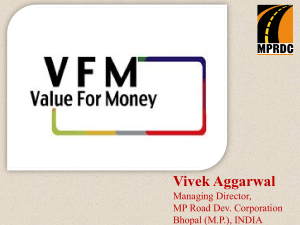A VFM toolkit and self-assessment template
advertisement
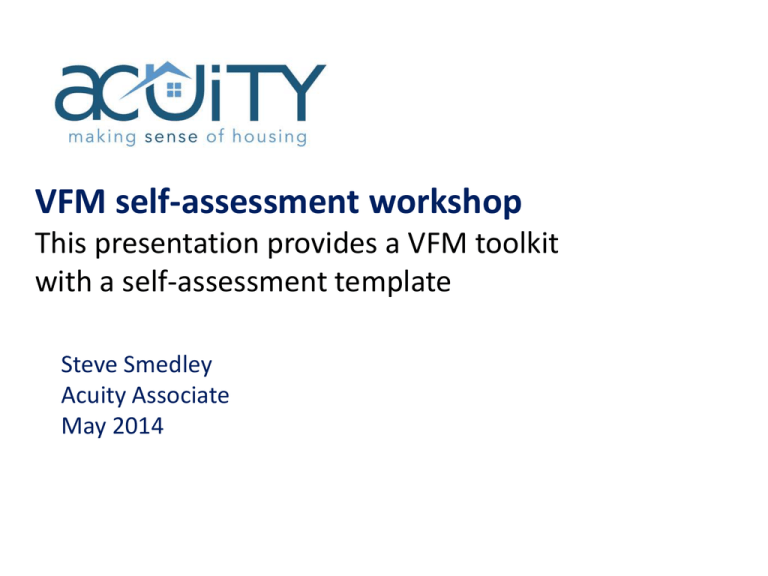
VFM self-assessment workshop This presentation provides a VFM toolkit with a self-assessment template Steve Smedley Acuity Associate May 2014 Workshop aims To provide delegates with the tools and information to meet the regulatory requirement to publish an annual VFM self-assessment via: 1. Understand the updated regulatory context and emerging lessons from Year 1 2. Take a look at the key ingredients of a VFM self-assessment 3. Challenge personal thinking through debate It’s your day … … informal and participative Part 1: morning – 10:00 – 12:45 Introductions Regulatory context brought up to date Observations & lessons from Year 1 What has the HCA been saying about year 2 What might a self-assessment look like? – overview Lunch (& registration for PM attendees): 12:45 – 1:30 Part 2: afternoon – 1:30 – 5:00 What might a self-assessment look like? – the detail Some thoughts from me Some thoughts from you - looking back and forward Last thoughts It’s your day … … informal and participative 11am – 1pm - Part 1 Introductions Regulatory context brought up to date Observations & lessons from Year 1 What has the HCA been saying about year 2 1-1:45pm - Lunch 1:45 – 15:00pm - Part 2 What might a self-assessment look like? • Some thoughts from me • Some thoughts from you Last thoughts PART 1 Before dropping into Wonderland • Who you are? • What you do? • What you want to get out of today? • Any particular issues, hangups? REGULATORY CONTEXT …UPDATED Co-regulation Compliance Horrible histories: VFM This assumption is what your self-assessment is trying to dispel. Once upon a time, the government proclaimed that the public sector should be more efficient. Best value and VFM were prescribed and inspectors checked compliance. Fast fwd: VFM regulation now Review of Social Housing Regulation 2010 we expect in future the regulator to be more proactive…on ensuring VFM…to achieve better returns for the taxpayer & support new affordable housing supply Purpose of economic regulation (current Regulatory Framework): to protect historic government subsidy, promote access to private finance, and help address the lack of competitive pressures on providers which might otherwise put pressure on service quality and efficiency VFM regulation now • Same set of standards apply to RASAs as 1000+ • Assurance-based approach to regulation • • • • aim to obtain sufficient evidence (assurance) standards are being met starting point is HAs’ own assurance on compliance with standards HCA wants assurance that the board is assured! HCA guided by 8 question engagement framework • Q5 does the organisation demonstrate how it achieves VFM in meeting its strategic objectives? • requires a review of the assurance provided to board on the strategy for & achievement of VFM • so VFM self-assessment is key evidence/assurance • ability to drive VFM a key indicator of quality of governance What the VFM standard is trying to achieve & what the HCA is seeking assurance on Desired outcomes are no more than what an effective board will already be doing - HCA looking for assurance that: • providers have comprehensive & strategic approach to VFM that is board-led • boards clear about: • their strategy • how the business is structured • how its resources are applied to deliver their plan • providers have effective performance management & scrutiny functions • boards understand ROA, consider their use in the round & seek the best strategy for delivering value from them, whilst meeting organisational objectives • providers operate efficiently & effectively as possible, seeking to control and optimise the relationship between costs and quality of services • providers are as transparent as possible about the above and can be held to account by key stakeholders Matthew Bailes et al spring 2014 Round up of implications • VFM now about the whole business – not just services • value tagged to your objectives not 3rd party • but has to reflect the value perspective of stakeholders –publicly listed businesses maximise shareholder value –social businesses maximise stakeholder value? –raises tension between stakeholder value perspective eg • existing v future tenants • government (build) –v- sector (beyond bricks ‘n’ mortar) • board/exec reconcile this • self-assessment is a stakeholder doc • reality check – VFM & (social) business effectiveness the same thing • can you measure the value you exist to produce? – your product Round up of implications • greater emphasis on boards • opportunity for the sector: •demonstrate it can do co-regulation •define value positively, in social business terms • not just about cost cutting • counter anti-social housing sentiment with a better story • assert significance of sector • but avoid PR exercise • HCA not dictating terms (yet): •business model, allocation of resources: supply-v-servicesv-support-v-community investment •organisational form – group, merge, etc •operating structure, suggested costs, service levels • but there is dissonance between regulation and politics VFM self-assessment - first principles Purpose of self-assessment = demonstrate to stakeholders how meeting the VFM standard So what’s in standard? • ‘doing’ VFM • articulate & deliver a comprehensive & strategic approach to VFM to meet objectives • application of 3 Es • ‘reporting’ VFM • reflects stakeholder interests • robust • transparent • accessible HCA specifically interested in these specific expectations!..... especially the last 3…so specifically address them! Any specific expectations? • ‘doing’ VFM • robust approach to use of resources • understanding RoA & strategy for optimising returns • effective performance management & scrutiny • understand service costs, outcomes & drivers • ‘reporting’ VFM • enable understanding of RoA • set out absolute & comparative costs of specific services • evidence VFM gains (backwards & forwards) The VFM standard. What do you think? Any observations, issues? Observations on year 1 • • • • • unhappy with sector response – VFM not taken seriously VFM mood music changed last autumn failure of compliance rather than failure of VFM downgrade G rating by one notch HCA’s ‘presentational problem’ –communicating disappointment to sector without government using it to further beat unloved sector & regulator • HCA unlikely to be more prescriptive – counter co-regulation • smacks of box ticking & avoiding responsibility for managing the biz themselves • BUT HCA has given us some pointers…….(to be revisited) • sector appears unhappy with HCA’s handling • risk of compliance mind-set resurfacing? Your take? Observations on year 1 Determining what was required • uncertainty about requirements How was it • level of detail? for you? • where and how to publish? • accessible –v- comprehensive/technical? • many opted for summary in accounts and detail on website Roles • extensive board sign-off but scope for more involvement in process • understanding, challenging, owning output • shaping the SA • special role for audit committee • only third used tenant scrutiny – obvious role here • little reference to input from other stakeholders or even their perspective Observations on year 1 How was it for you? Return on assets • wide interpretation – what was expected? Clarity required? • methodological & contextual issues militate against useful KPI • but killer headline metric not required • improving understanding of stock biz critical going forward Absolute & comparative costs • use made of HouseMark data What data did • sometimes limited in OFR but more elsewhere you use? • some not stated costs – difficult to understand Evidence of gains • HouseMark data, VFM registers, procurement, commercial return • tenant scrutiny, awards, accreditations not mentioned • key issue – evidence your gains (& performance), better understand social value Observations on year 1 Dissemination • need to rationalise the docs that tell us about biz effectiveness? OFR+? • improve accessibility & transparency • tone down PR • reporting non-financial outcomes – learn from social accounts How about Benefits you? • majority saw value in process as biz tool Regulatory improvements • clarify expectations – fine line prescription –v- clarity of expectations Self-assessment structure: different strokes HouseMark/S&P approach Corporate priority approach VFM standard compliance approach You don’t have to do it like this! Self-assessment approaches (templates) The HouseMark/S&P • • • • • • definition of VFM in context of purpose & objectives strategic approach to VFM and use of resources arrangements to deliver VFM – performance management and governance what has been achieved plans for next year board assurance on the VFM self-assessment to be revisited The Compliant • • • • • background – ie HCA requirement what VFM means to us & how seriously we take it in terms of strategy & delivery (ref standard) return on assets absolute & comparative costs past & future VFM gains Some take a KLOE approach • distil standards’ principles • assess –v- criteria What kind of approach do you favour? The Corporate • • • • • overall judgement definition of VFM in context of purpose & objectives corporate objective #1 • aim • arrangements to ensure delivery • achievements • plans corporate objective #2 • ditto etc Good practice from the sector? • Helena** (infographic, varied approach to measuring asset and social return) • GreenSquare* (honest, comprehensive, had a bash at ROI, embedded VFM, bottom-up VFM - GreenState) • Riverside** (honest, SA as improvement & accountability tool inc action plan, outcomes from stakeholder perspective, involved others in process) • Notting Hill* (ROCE by business stream, active asset management, good use of G15 benchmarking and commentary) * in OFR, ** separate VFM statement Good Practice caveat: • how consistent is HCA in its approach to assessment? • up the ante - great expectations year 2 • smaller HAs – need a proportionate approach Evidencing (measuring) VFM performance A VFM scorecard - for self-assessment & general biz tool? Process Value achievement Value VFM scorecard People Value creation Biz health • • • • limited set of common metrics emphasis on performance not context but should be considered –v- context comparable evidence base for: • credible VFM story • understanding business effectiveness • complements corporate scorecard (not always metric-based) Evidencing (measuring) VFM performance + local metrics, eg = credible evidence base to local offer hang narrative on + qualitative evidence, eg scrutiny, reviews, awards to be revisited What did HCA do? Any evidence of getting shirty with smaller HAs? • looked at around 240 self-assessments (ie 1000+ stock with March year end) • 15 non compliant – 14 downgrades • 160 got a partial compliance (naughty) letter threatening potential downgrade if no improvement • why downgraded? • insufficient assurance that there is a strategic approach to VFM • not communicated to stakeholders in a transparent and timely manner (ie missed deadline) So key issue – the provision of sufficient evidence for HCA to be assured ‘VFM self-assessment is about evidencing the VFM story….’ What has HCA been saying is good?: key messages for 2014/15 • Good self-assessments transparently permit stakeholders to understand performance against the specific requirements of the standard: NB focus on 3 specific sufficient detail to allow stakeholder to make own assessment requirements balanced commentary - a reasonable interpretation of results clear info on ROA* and how this has been used to inform decisions on the management of the asset base • quantified evidence on cost of delivering specific services*, compared with: • previous years • relevant peer group • & clear links between cost & quality of outcomes • no cherry picking good stuff – consider cost & performance, strengths & weaknesses in context of overall spend • systematic evidence of past VFM savings and specific, ambitious, measurable targets for future. Links made between savings & gains & achievement of provider’s overall strategy. Matthew Bailes et al, spring 2014 * NB the principles of Regulatory Framework expect continuous improvement in use of assets and costs. HCA is looking for ‘sufficient evidence’ to enable judgements on this • • • …..& poorer self-assessments… ..did not The HCA’s key messages for 14/15 • signpost other key documents in your board report / OFR • no room for complacency. For most what was good enough in 2013/14 won’t be good enough next year. NB raising the bar ..the sector should not underestimate the government’s & regulator’s interest in VFM…… • Matthew Bailes, May 2014: ask yourselves • does the self-assessment give the reader enough information to make a judgement on whether your organisation offers VFM in delivering your objectives compared to your peers? • does it give them enough information to judge whether you are doing better or worse than last year? NB continuous improvement in VFM is about beneficial change in cost &/or performance WHAT MIGHT A VFM SELF-ASSESSMENT LOOK LIKE?: THE PRINCIPLES Key principles for self-assessment • include a comprehensive VFM self-assessment in OFR/board report • signpost to even more comprehensive documents if required – make sure these documents are available and accessible in good time • form & content of the self-assessment is based on HA’s social purpose and stakeholder interests • there is no template • suggest narrative backed by evidence (eg data, qualitative info) • no evidence = fairy story • but just killer metrics – fails to tell full story • VFM ultimately a qualitative judgement based on assessment of available evidence Key principles for self-assessment • it is a stakeholder document – be clear about who you produce value for: • what do they want and how much have you achieved for them? • is it more or less than last year? • invite challenge • demonstrate board ownership of VFM – allow time for the board to consider, discuss and challenge the self-assessment: • do they understand it? • does it address the requirements of the standard? • is it robust? • sufficient evidence/assurance • any limitations or gaps – if so what and how will it be addressed • does it represent a true & fair VFM story or just a fairy story? Key principles for self-assessment Key principles for self-assessment • it should be robust and transparent • comprehensive account of how the association is faring with regards to improving VFM, warts & all , strengths & weaknesses, in the round • evidence-based! - provide sufficient evidence for stakeholders to make their own judgements – commentary should represent a fair and balanced analysis of evidence facilitating judgement • self-assessment is not a PR exercise but an accountability and improvement tool • it should be accessible to stakeholders • infers that report is intelligible and its availability communicated to stakeholders. • data visualisation key Key principles for self-assessment Key principles for self-assessment Content: • consider including a compliance statement - to what extent does the HA comply with the requirements of the standard and what does it plan to do about areas on non/partial compliance? • demonstrate • a strategic approach to VFM including a robust approach to use of resources • the performance management & scrutiny arrangements to achieve strategy (including governance and tenant scrutiny). This is about demonstrating a grip on VFM via arrangements to ensure its delivery Key principles for self-assessment Key principles for self-assessment Address HCA’s specific requirements: a) should enable stakeholders to understand the return on assets measured against the organisation’s objectives – provide evidence that you have a grip on asset management - that you: • understand stock condition & associated investment needs • understand maintenance costs • understand demand, the communities & markets you operate in • understand the return in financial, social and environmental terms at an appropriate level of detail: what level? What does the data tell you? • demonstrate that the above understanding informs • intelligent asset management strategy that aims to improve returns • intelligent business decisions, eg hold, invest, dispose, convert, etc • understand the benefit of investment on future rental stream/social outcomes & only invest where the return is clear….. • …consider brief assessment of key asset decisions over year – cost/benefit • flag weaknesses for transparency, remedial action? Key principles for self-assessment Key principles for self-assessment b) set out the absolute and comparative costs of delivering specific services and demonstrate you understand service costs, cost drivers and associated outcomes, ie that you have a grip on operational cost and performance. • evidence here includes benchmarking data, business metrics and qualitative info eg: tenant scrutiny, service reviews, accreditation, feedback. • Acuity/HouseMark data key evidence base – compare self over time and against others but avoid gaming • brief commentary on headline unit costs, PIs, other evidence • what can you do about your cost drivers? • what are you doing to contain overheads? • what can you say about the efficiency/effectiveness of operating model? • strengths & weaknesses • explain direction of travel – costs/value up or down Key principles for self-assessment Key principles for self-assessment c) evidence of past and prospective VFM gains • set key gains against overall cost base and in context of mission • quantify the gain financially, socially (performance, satisfaction, # beneficiaries, etc), environmentally • how was it achieved? • own up to any negative impacts, costs etc • what will you use surplus for? • future gains • what will you do? • what is the anticipated financial, social, environmental gains in context of mission – can you quantify these? • are there any costs or diminution in service associated with them? • over-promise, under-deliver is a risk – self-assessment is a record Dropping the principles into a template? 1. Overall summary statement of VFM performance & compliance with standard 2. Define VFM in context of objectives & stakeholder interests Overall, we meet the requirements of the standard…notable achievements include x. We need to address y... For us VFM means…… 3. Provide assurance about ‘how you do’ VFM Our arrangements for ensuring VFM are… 4. Evidence-based VFM reporting (warts ‘n’ all) – ‘how we did and what we plan to do’ Narrative that draws on data & qualitative evidence & addresses specific HCA reporting expectations You don’t have to do it like this! to be revisited Thoughts, observations? Lunch PART 2 Recap & agenda Part 1: morning • Introductions • Regulatory context brought up to date • Observations & lessons from Year 1 • What has the HCA been saying about year 2 • What might a self-assessment look like? – overview Part 2: afternoon – 1:30 – 5:00 • What might a self-assessment look like? – the detail • Some thoughts from me • Some thoughts from you - looking back and forward • Last thoughts Exercise 1 – How was it for you? In small groups, reflect on your organisation’s experience of producing a VFM Self Assessment last year: 1. 2. 3. 4. What kind of structure and evidence? What worked well? Outstanding difficult issues? What lessons have you learnt? Write brief flipchart notes Be prepared to feedback as part of discussion STEPPING THROUGH THE PROCESS Dropping the principles into a template? 1. Overall summary statement of VFM performance & compliance with standard 2. Define VFM in context of objectives & stakeholder interests Overall, we meet the requirements of the standard…notable achievements include x. We need to address y... For us VFM means…… 3. Provide assurance about ‘how you do’ VFM Our arrangements for ensuring VFM are… 4. Evidence-based VFM reporting (warts ‘n’ all) – ‘how we did and what we plan to do’ Narrative that draws on data & qualitative evidence & addresses specific HCA reporting expectations You don’t have to do it like this! Focus on step 1. Compliance & summary statement, including board assurance high level summary of VFM performance – key strengths and weaknesses, is VFM improving? How we did summary by stakeholder? compliance statement to what extent does the HA comply with the HCA’s VFM requirements? is the Board assured: this is a fair and balanced account of VFM? of the robustness of this self-assessment sufficient evidence/assurance? limitations or gaps? how will non-compliance be addressed? invite feedback & challenge by stakeholders Issues? Solutions? Focus on step 2. What VFM means to us: our VFM definition • assert social mission, vision and objectives - it’s why you exist! – unpack key ‘value streams’ (outcomes), ie new homes, great services, community well-being, care & support • identify key stakeholders and what they value – your audience & beneficiaries of your value! • based on above, assert a short VFM definition - essentially ‘for us VFM is maximising ‘our value’: more homes, better services, more lives improved…….’ • great opportunity to boldly assert your value proposition Focus on step 3. Arrangements to ensure VFM – a strategic approach & the means to deliver it • to demonstrate grip on VFM strategically and operationally • set out key principles of VFM strategy - state that it is a considered strategy, eg: • based on fact/previous assessment • has meaningful improvement actions linked to it (pick these up in step 4 when reporting past/future gains!) • corporate fit with key strategies: risk, asset, people, procurement etc. • no VFM strategy ? - consider how the biz strategy drives biz effectiveness/VFM If you have a VFM strategy this is where it probably fits?..... Operations Strategic planning VFM Self Assessment Purpose, objectives … Corporate strategy Financial plan VFM strategy People strategy Asset strategy VFM action plan Procurement strategy Service delivery plan Focus on step 3. Arrangements to ensure VFM – a strategic approach & the means to deliver it What can you say about how you ensure the right amount of money is spent on the right things (social biz objectives)?: o rigour of business/corporate planning process o use of robust business cases - based on evidence/data (and not historical costs) & understanding of benefits o quality of debate and challenge Focus on step 3. Arrangements to ensure VFM – a strategic approach & the means to deliver it • governance & performance management arrangements associated with planning, delivery and evaluating VFM eg: • VFM roles of board, exec, other staff, tenants, eg • respective roles in accountability & challenge • tenant involvement in VFM: agreeing priorities, shaping services & scrutinising service performance and VFM • assurance and reporting framework for VFM eg • how is VFM reported within the HA? • how is VFM measured? Which tools? • extent VFM is embedded, eg performance management, cost control, procurement practice, etc • strengths & weaknesses of your approach? Issues? Solutions? Step 4. How we did & what we plan to do VFM scorecard/metrics as evidence base to hang story on Alternatively take each corporate objective in turn. + Assets Operations Procurement Treasury Surplus & intended use Pithy commentary on key activity areas supported by evidence Step 4. How we did & what we plan to do a) Provide evidence that you have a grip on asset management ie that you: • • • • understand stock condition & associated investment needs understand maintenance costs understand demand, the communities & markets you operate in understand the return in financial, social and environmental terms at an appropriate level of detail: what level? What does the data tell you? • demonstrate that the above understanding informs • intelligent asset management strategy that aims to improve returns • intelligent business decisions, eg hold, invest, dispose, convert, etc • understand the benefit of investment on future rental stream/social outcomes & only invest where the return is clear….. • …consider brief assessment of key asset decisions over year – cost/benefit • pick up past improvement actions – quantify gains/benefits • strengths and weaknesses of current approach to assets Step 4. How we did & what we plan to do a) operations • set out the absolute and comparative costs of delivering specific services (use HouseMark VFM dashboard & quadrant /Acuity metrics to compare self over time and against others) • other evidence here includes business metrics, local offer data, care indicators and qualitative info eg: tenant scrutiny, service reviews, accreditation, feedback. • brief commentary on headline unit costs, PIs, other evidence • what can you do about your cost drivers? • what are you doing to contain overheads? • what can you say about the efficiency/effectiveness of operating model? • strengths & weaknesses • explain direction of travel – costs/value up or down • highlight key VFM initiatives and (quantified) benefits, eg from VFM register, previous VFM action plan, movement in HouseMark/Acuity data • how were they achieved? • set gains against overall cost base. Own up to any negative impacts, costs etc • ROI of commercial activity Step 4. VFM achievements c) key procurement gains not already covered at a) or b) d) treasury management brief ref to the cost of capital, debt management strategy and any evidence of savings from active debt management. How does the cost of capital compare? use made of borrowing capacity to achieve development outcomes in context of: o board’s agreed approach to risk and future business plans o limitations: covenants access to affordable finance NB this is about managing stakeholder expectations as much as reporting VFM e) state surplus & how gains/surpluses will be used to produce more VFM Issues? Solutions? What I’ve just said as a picture Narrative backed by data costs –v- service outcomes, social & economic benefits, environmental benefits Assets Operations It’s all social value! Procurement financial benefit savings, income, etc Treasury Management financial benefit savings, income, etc Surplus Borrowing capacity looking ahead – even more social value Data sources/evidence base VFM strategy & action plan benchmarking/HCA regression analysis internal scorecard key asset management local offer performance decisions – cost/benefit impact assessments, Assets Operations SROI, etc satisfaction Procurement key procurement items tenant scrutiny work – cost/benefit accreditation, service review, internal audit, etc Treasury Management Financial returns Surplus Borrowing capacity VFM register Step 4 variation based on corporate plan • corporate objective #1 – aim – achievements – plans • corporate objective #2 – ditto Caveat - but need to ensure don’t lose sight of regulatory requirements by following the line of thinking in your corporate plan Step 4. Improvement Plans for next year • what will you do? • pick up weaknesses, improvement actions already identified – your VFM action plan going forward • what is the estimated (quantifiable) benefit in financial, social and environmental terms • pick up weaknesses mentioned elsewhere • any costs or diminution in service associated with them? Issues? Solutions? ….and don’t forget to communicate • disseminate • • • who? OFR/board report! signpost timeliness • accessible • • find it? understand it? • language • graphics EVIDENCING (& MEASURING) VFM Evidencing (measuring) VFM performance A VFM scorecard - for self-assessment & general biz tool? Process Value achievement Value VFM scorecard People Value creation Biz health • • • • limited set of common metrics emphasis on performance not context but should be considered –v- context comparable evidence base for: • credible VFM story • understanding business effectiveness • complements corporate scorecard (not always metric-based) Evidencing (measuring) VFM performance + local metrics, eg = credible evidence base to local offer hang narrative on + qualitative evidence, eg scrutiny, reviews, awards What kind of metrics? Process % rent collected % service charge collected average re-let time (all voids) calls handled at first contact or another key customer process PI repairs at first visit/equivalent satisfaction or net promoter with employer? or staff engagement? sickness absence staff turnover ratio top earner to bottom or median earner measures on say board effectiveness or staff development? People Value net increase in stock satisfaction with new home net promoter/satisfaction with service satisfaction with repairs satisfaction with neighbourhood % tenants who think rent/service charge is good VFM #/% beneficiaries – employment? #/% beneficiaries - training & education? #/%/£ beneficiaries – income inclusion? growth turnover net increase in stock operating margin operating costs as % turnover • management, maintenance, development overheads non-social housing turnover % spend non-social % margin non-social arrears as % Biz void loss as % bad debt as % health effective interest rate leverage Building a picture of value with metrics Social mission •identify kind of value •new homes (V1) •great tenant services (V2) •care & support (V3) •added value (V4) •commercial return? Kind of value Kind of objectives Kind of measures Metrics need to map to value •map existing metrics •fill gaps •metrics •other forms of evaluation •reviews, awards etc •tenant scrutiny •impact studies Telling the story: where the value lies Complement metrics with key reviews, awards, scrutiny, impact studies, social accounts? Customer Satisfaction with quality of new home* V1 Satisfaction with overall services provided* V2 Satisfaction with maintenance* V2 % jobs right first time V2 Net promoter* V2 Fuel poverty PIs? Your key Care & support PIs (V3) could be included here too eg QAF. Average SAP rating* V2/4 Satisfaction neighbourhood * V2/4 •# found employment V4 •# apprenticeships created V4 •# completing training course V4 •# provided financial advice V4 •satisfaction with intervention V4 •£x invested of own money •£y leveraged NB NHF audit categories as basis for typology Community & LA • Key local promise PIs (in accordance with consumer regulation) V2 • Arguably, surplus, leverage • Net increase in stockV1 • Regulatory rating Regulator & government Developing a VFM scorecard toolkit Metrics in blue collected by Acuity Don’t panic!!!!! I’m not suggesting you use all of the following metrics – simply pick the best that work for you depending on: a) the nature of your business and the value you produce b) how much effort you want to put in Business health source: accounts, Acuity, HouseMark • business growth • operating efficiency & profitability – margin eg – growth in turnover • operating margin – growth in assets • EBITDA MRI margin – operating cost per unit – net increase in stock • management cost – new biz income • maintenance cost • debt servicing & use of assets – income protection • arrears as % rent due – net leverage/gearing • FTA as % rent due – debt per unit • void loss as % rent due • bad debt/write off – EBITDA MRI interest cover – effective interest rate – return on assets Clearly lots more to choose from but what do you think are the key metrics? People source: local PIs, Acuity, HouseMark • • • • average days lost to sickness staff turnover staff/board satisfaction could consider: – customer service accreditation – local measures associated with training and developing staff Clearly lots more to choose from but what do you think are the key metrics? Business processes source: local PIs, Acuity, HouseMark • • • • • • • • % rent collected % service charge collected % repairs completed in target time % units vacant & available % units vacant & unavailable average re-let time tenancy turnover other key processes where effectiveness matters, eg gas safety, ASB case handling, budget achievement? Clearly lots more to choose from but what do you think are the key metrics? Value source: local PIs, Acuity, HouseMark Complement metrics with reference to any key impact studies Customer Satisfaction with quality of new home* V1 % homes failing Decent Homes Standard* V2 Average time to complete a repair* (days) V2 Satisfaction with maintenance* V2 Satisfaction with overall services provided* V2 % jobs right first time V2 Net promoter* V2 % tenants who think rent/service charge is good VFM V2 Satisfaction with outcome of complaint V2 % satisfied with complaint handling V2 % satisfied staff were able to deal with their problem V2 Average SAP rating* V2/4 Your key Care & support PIs (v3) could be included here too eg QAF. Satisfaction outcome of ASB case* handling V2/4 Satisfaction with neighbourhood as a place to live* V2/4 Typically the most frequently used measures are # beneficiaries of a given intervention, eg • # tenants provided with financial advice • # tenants helped into sustainable work • # tenants completing vocational training course • # tenants completing skills training • # apprenticeships created • # kids attending diversionary activity Can also include satisfaction with intervention Also: • £x invested of own money • £y leveraged Community & LA Percentage of tenants who are satisfied that views are listened to and acted upon* (co-reg) V2 • Include any key local promise PIs in accordance with consumer regulation V2 • Net increase in stockV1 Regulator & government Exercise 2: What should it look like? In the same groups, based on what you’ve heard and the suggested templates, what should it look like?: 1. 2. 3. 4. What kind of structure? What kind of evidence? How would you improve it to make it your own? Remaining difficult issues? Write brief flipchart notes Be prepared to feedback as part of discussion Last thoughts, issues • have you got the tools and information you need to take this forward? • anything not dealt with? • consider a buddy system for peer challenging your SAs • Acuity support also available Steve Smedley 07814 424426 Steve.smedley@skillsprojects.co.uk
